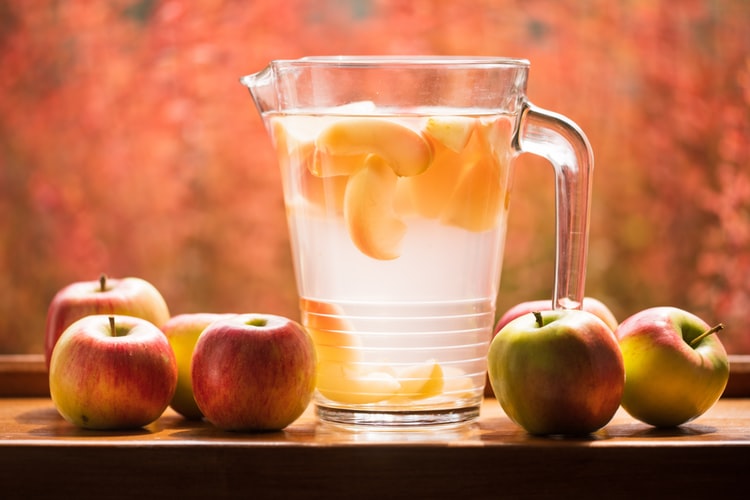Apple cider vinegar from popular brands can be quite costly and often do not contain the valuable ‘Mother’ component. The ‘Mother’ is present in raw ACV and is rich in probiotics, minerals, and enzymes that are beneficial for the body. Making your own ACV allows you to preserve the ‘Mother’ and produce large amounts at a fraction of the cost. In this article, we will explore the steps to make apple cider vinegar at home.
Click to skip directly to the section ‘How To Make Apple Cider Vinegar’. Here you can find photos and the video on the whole acv making process.
To know more about apple cider vinegar benefits and various recipes check out, Apple Cider Benefits For Skin, Hair And Health With DIY Recipes
WHY MAKE APPLE CIDER VINEGAR AT HOME
A 500 ml bottle of high-quality ACV with ‘Mother’ such as Braggs can cost between 450-499/-. However, by using baby apples that cost approximately 115/- per kg, I was able to make 1.5-2 litres of raw ACV, using only 7-8 apples and a two-litre glass jar. This means that you can save a considerable amount of money while having access to pure ACV, unlike the filtered and pasteurised ones sold in the market. Additionally, this recipe uses honey instead of sugar, making it even healthier. It is doubtful that commercial companies treat their apples with baking soda to remove pesticides. Therefore, learning how to make apple cider vinegar at home is always a better option.
HOW APPLES TURN TO VINEGAR
The process of producing ACV involves two stages of fermentation.
First Stage – Water to Alcohol: Bacteria and yeast break down the sugars present in the apples, converting them into alcohol. This step typically takes 2-4 weeks. As soon as the water transforms into alcohol, the apples sink to the bottom of the jar. At this point, it is crucial to filter the apples and remove them since they are no longer necessary for the remainder of the process.
Second Stage – Alcohol to Vinegar: This fermentation stage takes approximately 3-6 weeks to complete. It is important to stir the mixture every 3-4 days to promote oxygen circulation.
HOW TO SPEED UP THE FERMENTATION PROCESS
By adding ACV or mother to a new batch, you can accelerate the fermentation process. Another way to speed up the process is by using a sachet of ‘Champagne yeast’. These methods save time and avoid starting the fermentation process from scratch, which usually takes longer to convert sugars to alcohol.
Personally, I always add ACV with mother when preparing a new batch. During summers, the first fermentation process takes only 2 weeks using this method. However, I have yet to try this in winter.
The number of apples depends upon the size of your container. If you have a large pickle barrel, then sure go ahead and make use of it. If you are making ACV for the first time, do a trial run using just three apples. That is what I did.
The number of apples depends upon the size of your container. If you have a large pickle barrel, then sure go ahead and make use of it. If you are making ACV for the first time, do a trial run using just three apples. That is what I did.
NOTES
I have compiled a list of nine crucial points that you must bear in mind when making ACV. These tips are based on my personal experience and can help simplify the process, ensuring that you produce high-quality ACV without encountering any mishaps.
📌 USE BAKING SODA
Adding baking soda to water can eliminate 96% of pesticides in just 12 minutes. Therefore, to clean your apples, soak them in water containing baking soda for approximately 15 minutes.
For 2 cups of water you need to add 1 teaspoon of baking soda.

📌 AVOID METAL CONTAINERS
When using metal, there is a risk of the vinegar interacting with the material and causing it to corrode. Additionally, the ACV may acquire a metallic taste, which is undesirable. Therefore, it is advisable to use wooden, ceramic, glass, or enamel jars instead. Grandma’s old pickle jars are an excellent option for making apple cider vinegar.

📌 MAKE SURE THE JAR IS CLEAN AND DRY
Ensuring that the jar is both clean and dry is critical to prevent the ACV from becoming contaminated by other bacteria. The presence of unwanted bacteria can cause mold growth, which may ultimately ruin the entire batch of ACV. To avoid this, it is recommended that you clean the jar thoroughly and let it air dry before use.
📌 MAKE SURE THE APPLES ARE SUBMERGED IN WATER
When the apples float on top of the water, they are at risk of rotting and promoting mold growth, which is undesirable. To prevent both of these outcomes and promote proper fermentation, it is essential to weigh down the apples using a weight. This will keep the apples submerged in the water and help prevent them from floating to the surface.
📌 USE A BREATHABLE CLOTH TO COVER THE JAR
What is the purpose of using a cheese cloth?
The cheese cloth allows for easy circulation of air, which is crucial for the successful completion of the fermentation process. By covering the glass jar with a cloth, it is possible to allow the jar to breathe, enabling the gases generated during fermentation to escape easily.
📌 STIR OCCASIONALLY
Why do we need to stir at all?
Stirring helps the oxygen to reach all parts of the liquid. Adequate oxygen is required for the fermentation process to continue.
- For the first 2-4 weeks (Until apples sink) – Stir everyday or once every two days
- For the next 3-6 weeks – Stir once every 3-4 days.
📌 KEEP THE JAR IN A DARK PLACE
What are the optimal conditions for making ACV?
The ideal temperature range for making ACV is between 15-25 degrees Celsius, and the jar should be kept away from direct sunlight and heat sources. Higher temperatures can interfere with the formation of the “Mother,” so it is best to keep the jar in a cool, dark place.
The ACV can also attract small flies, which may land on top of the cheesecloth. To prevent this, it is advisable to keep the jar inside a kitchen cabinet or other enclosed space. Additionally, the time required to make apple cider vinegar can vary, with longer fermentation times needed in colder climates and shorter times required during hot summers.
📌 WHITE SCUM LAYER – DON’T PANIC
If you notice any scum during the first 2-4 weeks of fermentation, it’s important to remove it using a wooden utensil. However, if you notice a white scum layer forming after discarding the apples (around 2-4 weeks later, as mentioned in Step 8), there’s no need to worry as it will eventually turn into the ‘Mother’ in a few weeks.
It’s only necessary to remove the scum if it appears to be a different colour, which is unlikely to happen if you’ve used clean jars and utensils.
📌 USE WOODEN UTENCILS
We totally recommend using wooden ladles for stirring the ACV during its fermentation process as, wood does not interfere with the acids and enzymes in it. Just make sure it is clean and dry before letting it touch the ACV.

WHAT YOU NEED
You need the below for making apple cider vinegar.
- Container – Any size but made of Glass/Ceramic/Wood
- Filtered/Boiled and cooled water
- Fermentation weight
- Cheesecloth
- Rubber Band
- Cleaned Apples – 8-10
- Honey or Any Sugar – 5 Tablespoons
- Optional – Few tablespoons of ACV or Champagne yeast
Here are the 10 steps to make homemade apple cider vinegar.
🍀Clean the apples. Leave the apples in baking soda solution for 15 minutes. After 15 minutes, scrub the apples with your hands and wash the apples under running tap water. Do not skip this step as pesticides can adversely affect your health.

🍀 Cut the apples in to small bite sized pieces. You can cut it in to 6-8 pieces

🍀 Transfer the apples to the glass container. Add filtered water to it until the apples are completely submerged.

How Much Water To Add?
Adding more water than necessary will make the fermentation process longer and adding less water will cause the apples to rot or cause mold to grow. Add just enough water until the apples are completely covered.
🍀 Add 5 Tablespoons of honey to it.

🍀 This is completely optional. Add 3 Tablespoons of ACV to it. It could be from the previous batch you made. You can also add the ‘Mother’ which is even better. OR Add one Champagne Yeast sachet to it. If you do not have it, skip it. It totally fine. We add either of the two to speed up the fermentation process.

🍀 Place a weight on top of the apples to weigh the apples down.
🍀Cover the opening of the jar with a cheesecloth. Fasten with a rubber band. Stir once a day or every two days till the apples sink.

2-4 WEEKS LATER – The apples sink down to the bottom of the jar like in the below picture.

🍀 Filter the alcohol and discard the apples.

🍀 Transfer it to a clean dry jar and cover the mouth with a cheesecloth.
Due to a spill that occurred while transferring, the amount of ACV in the glass may appear to be less than what it actually is. It should have a glass more than what is visible here. Remember to stir the mixture every 3-4 days.

3-6 WEEKS LATER – The alcohol has now turned to vinegar. It usually takes 3 weeks for me.
🍀Transfer the ACV to a bottle and close with a lid. Refrigerate to stop fermentation process or the acidity of the ACV will increase.
VIDEO INSTRUCTIONS
MY FIRST TIME EXPERIENCE
How to make apple cider vinegar at home, Trial With Just 3 Apples.
This was a couple of years back and the photos were taken on my phone. So please ignore the quality of the photos.
Ingredients
- Apples – 3
- Honey – 1 Tablespoon
I did not have baking soda with me so I just peeled the apples and used just the flesh.

Add enough water till it covers the apple pieces. I am using a 500 gram bottle here.

Add 1 tablespoon of honey to it.

Cover with cheesecloth. I did stir them once a day.
After 2-3 weeks, the apples sank to the bottom of the bottle.
Problem: The apples pieces were too small that within two weeks it kind of decomposed completely. So there weren’t much pieces left while filtering.
You can see in the picture below that the apple pieces are no where to be seen.
So lesson learned – Do not cut the apples in to super tiny pieces.

I filtered the liquid, discarded the apples and changed the bottle. After 3 weeks, There we have our apple cider vinegar.

Hope these pictures and video was able to make things easier for you. Now you have learned how to make apple cider vinegar at home. Try it as it is super easy and you can save lots of money. I will include ACV recipes (Health N Skin) in another article soon.
Till then, Have A Wonderful Time.
Read More DIY Recipes




